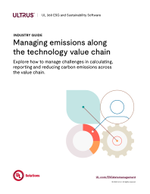
Scope 3 reporting along the technology value chain
Explore how technology companies can meet the challenges they face in calculating, reporting and reducing carbon emissions across the entire value chain.

As more of the world adopts technologies that require a tremendous amount of computing power — such as those leveraging artificial intelligence (AI), machine learning (ML) and quantum computing — the technology industry’s carbon emissions have the potential to skyrocket. In response to growing pressure from investors, regulators and customers, the industry’s investment in carbon emissions reporting and reduction is steadily increasing.
Until recently, the focus has been on reporting scope 1 emissions — direct emissions from sources that a company owns or controls — and scope 2 emissions — indirect emissions from the off-site generation of electricity, steam, heating and cooling bought and consumed by the company. Now, however, a greater emphasis is placed on scope 3 emissions reporting, which includes all other indirect emissions occurring in a company’s upstream and downstream value chain. Technology companies’ scope 3 emissions include those resulting from upstream activities, such as mining raw materials for device components, and downstream emissions, such as data center operations and electronic waste (e-waste). This category of emissions can comprise nearly 100% of a company’s total carbon output.
Collecting and analyzing reliable data from the long technology industry value chain in compliance with reporting requirements can prove complicated, time-consuming and costly, but UL Solutions’ experts are here to help. Read our industry guide to explore the growing importance of scope 3 transparency and the challenges technology companies face in meeting increasing scope 3 reporting expectations.

Scope 3 reporting along the technology value chain
Thanks for your interest in our products and services. Let's collect some information so we can connect you with the right person.